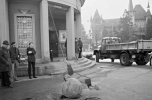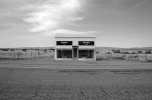The Disruption of the Cityscape
Text: Paul Virilio†
Translation: Ármin Tillmann
Even if a contemporary city may be still defined as a location or a geographical position, we should not mistake it for the contrast between the urban and rural, or that of the centre and the periphery. The concept that the fabric of the city possesses a well-defined site, orientation and direction, has not been self-evident for a long time now. The contours of the city did not break up with the flourish of suburbs: it was rather the fact that the contrast of intra muros and extra muros – especially in the wake of the revolutions of transport and cargo technology, as well as the new telecommunication devices – was neutralized meanwhile. This in turn resulted in the urbanization of the suburbs themselves. The phenomenon we are facing is actually a paradox in itself: the intransparency of the building materials converges to nil. At present structures resembling screens tend to appear in design organisation, where lightweight raw materials transparent like glass and various types of plastic substitute the wall system of facades; simultaneously, scheme studies are starting to contain carbon paper, transparent foil and plexi glass replacing the solid conveying medium of paper.



